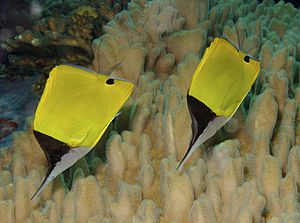Yellow longnose butterflyfish facts for kids
The yellow longnose butterflyfish or forceps butterflyfish (Forcipiger flavissimus) is a beautiful marine fish. It belongs to the butterflyfish family, known for their bright colors. This fish is found in warm, tropical waters all over the Indo-Pacific area. You can see it from the eastern coast of Africa all the way to Hawaii. It also lives in the Red Sea and the eastern Pacific Ocean, including places like Baja California and the Galápagos Islands. This small fish can grow up to 22 centimeters long. Sometimes, you might even spot it in aquariums!
Quick facts for kids Yellow longnose butterflyfish |
|
|---|---|
 |
|
| Conservation status | |
| Scientific classification |
Contents
Home Sweet Home: Defending Their Territory
Yellow longnose butterflyfish love their homes! They are very territorial, which means they protect their special patch of coral. They usually do this with one partner, staying together for a long time. This is called being monogamous.
Protecting Their Space
Even though they are often seen in pairs, these fish can sometimes get a bit feisty. They might chase away other yellow longnose butterflyfish of the same sex. For example, males chase other males, and females chase other females. Females mostly protect their food sources. Males, on the other hand, defend their territory to keep other males away from their female partner.
Why They Stay Together
Being territorial works well for these fish because their food, like small creatures on the coral, is usually found in the same spots. It's easy to predict where to find food. Their habit of staying with one partner seems to help them protect their home better. Two fish can defend a space more easily than one fish alone. Studies have shown that these pairs are made up of a male and a female. They can stay together for many years, sometimes even seven years or more!
Talking Without Words
Yellow longnose butterflyfish also have a cool way of showing who's boss. They make sounds! These sounds are like secret messages that help them communicate with other fish. They move their bodies in special ways to create these noises.
When a yellow longnose butterflyfish makes a sound, it can tell rivals how big it is. A longer and louder sound often means the fish is bigger and stronger. This helps them show other fish that their territory is well-protected. It's their way of saying, "This is my home, and I'm ready to defend it!"
- Photos of Forcipiger flavissimus in iNaturalist
See also
 In Spanish: Pez mariposa amarillo para niños
In Spanish: Pez mariposa amarillo para niños


